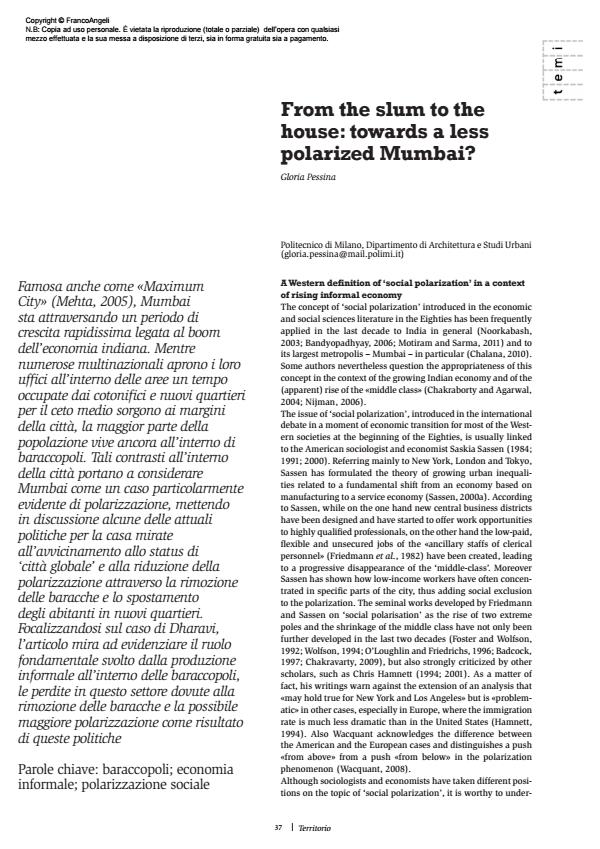From the slum to the house: towards a less polarized Mumbai?
Titolo Rivista TERRITORIO
Autori/Curatori Gloria Pessina
Anno di pubblicazione 2013 Fascicolo 2013/65
Lingua Inglese Numero pagine 7 P. 37-43 Dimensione file 532 KB
DOI 10.3280/TR2013-065005
Il DOI è il codice a barre della proprietà intellettuale: per saperne di più
clicca qui
Qui sotto puoi vedere in anteprima la prima pagina di questo articolo.
Se questo articolo ti interessa, lo puoi acquistare (e scaricare in formato pdf) seguendo le facili indicazioni per acquistare il download credit. Acquista Download Credits per scaricare questo Articolo in formato PDF

FrancoAngeli è membro della Publishers International Linking Association, Inc (PILA)associazione indipendente e non profit per facilitare (attraverso i servizi tecnologici implementati da CrossRef.org) l’accesso degli studiosi ai contenuti digitali nelle pubblicazioni professionali e scientifiche
Also famous as ‘Maximum City’ (Mehta, 2005), Mumbai is undergoing a period of extremely rapid growth as a result of the booming Indian economy. While numerous multinationals are opening offices in areas once occupied by cotton mills and new middle class districts are springing up on the margins of the city, most of the population still live in shanty towns. Contrasts like these within the city show Mumbai as a particularly clear case of polarisation, which raises doubts over some current housing policies designed to raise it to the status of a ‘global city’ and to reduce polarisation by removing the shanty towns and moving the inhabitants to new neighbourhoods. The paper focuses on Dharavi and attempts to highlight the fundamental role played by informal production in the shanty towns, the losses in this sector due to the removal of the shanty towns and the possible greater polarisation resulting from these policies.
Parole chiave:Shanty towns; informal economy; social polarisation
- Analyzing spatial polarization in Hyderabad's urban geography using Landscape Expansion Index (LEI) Shraddha Pandit, Arindam Biswas, in International Journal of Urban Sciences /2025 pp.1
DOI: 10.1080/12265934.2025.2595989 - Socio-spatial polarization in the urban neighborhoods of Hyderabad Shraddha Pandit, Arindam Biswas, in Journal of Housing and the Built Environment /2025
DOI: 10.1007/s10901-025-10233-x
Gloria Pessina, From the slum to the house: towards a less polarized Mumbai? in "TERRITORIO" 65/2013, pp 37-43, DOI: 10.3280/TR2013-065005